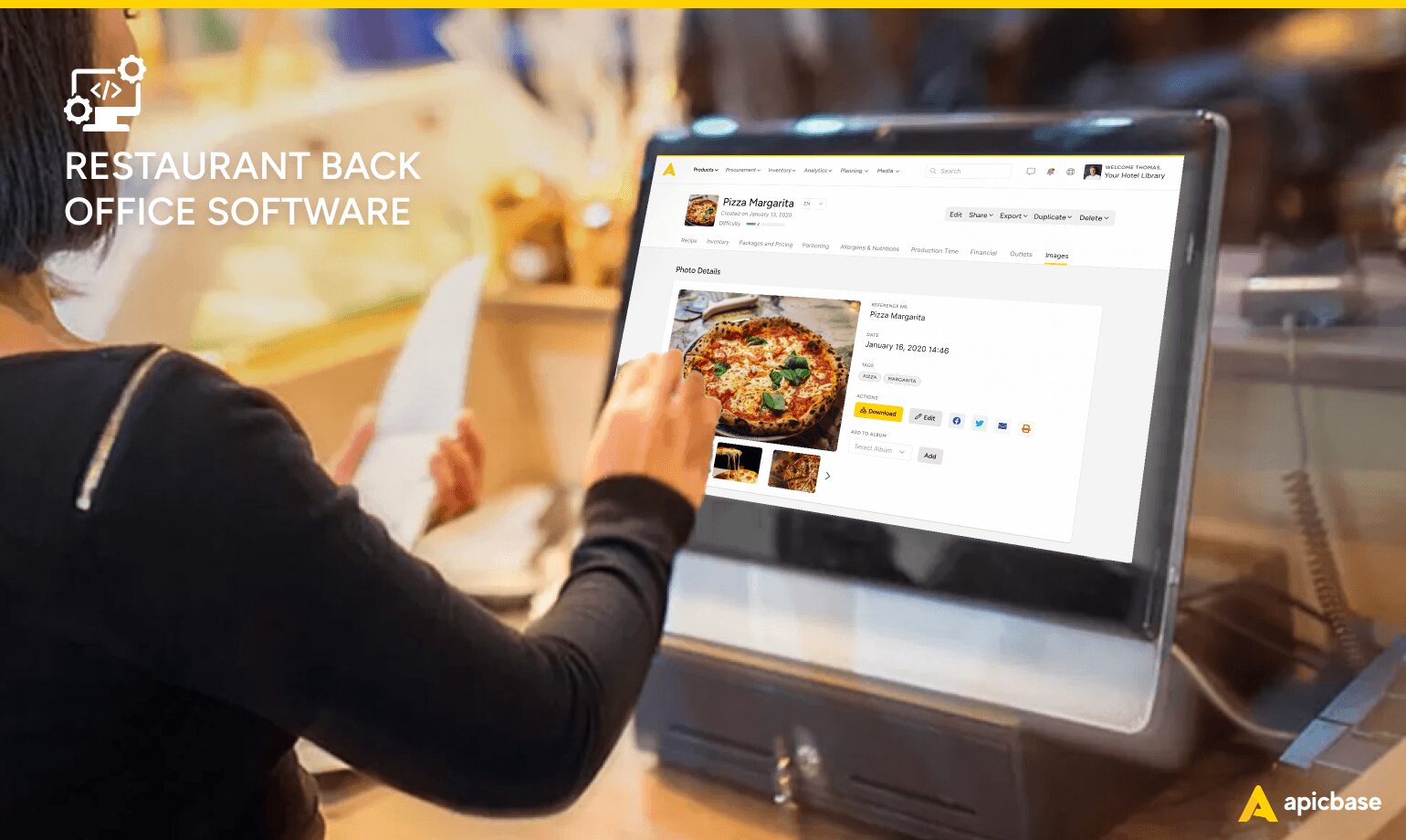Having the best POS system and a constant flow of customers might seem like a sure path to success, but without proper back-of-house management, your restaurants have little chance of making real money.
Customers generate revenue, but effective back-of-house operations keep costs in check, ensuring that your restaurants are also profitable in the long term.
The success of a food service business depends on how well its restaurant managers manage purchasing and inventory and how good the chefs are at creating profitable recipes.
In a small operation, you may expect your team to have the skills to do everything manually (although few experts will recommend that), but as the business grows, your employees will need the right tools to do their jobs well. That tool is back office software for restaurants. Its efficiency gains and cost savings are significant, even for one restaurant.
When your operation grows further and you manage a complex network of outlets, central kitchens, and production units, back office management software becomes essential. The benefits compound fast and are solid. These systems are pivotal in controlling costs and ensuring the financial health of your business.
Below, we discuss restaurant back office software and its benefits. Then, we move on to the essential features to look for when in the market for back of house software systems and valuable tips for when you’re ready to buy.
What Is Restaurant Back Office Software?
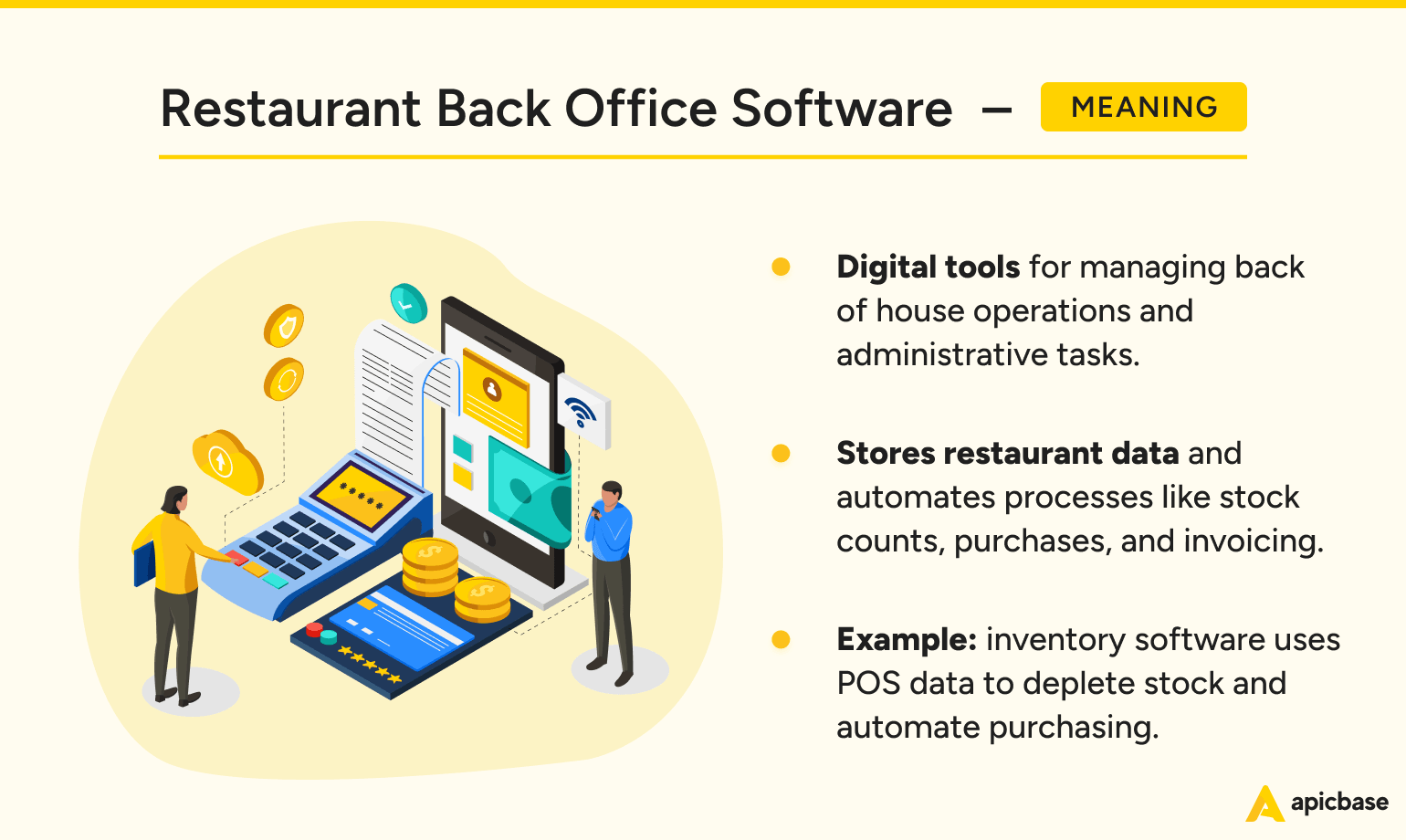
The restaurant back office, or back of house (BOH), is the non-customer-facing side of the restaurant business. Restaurant back office software refers to digital tools used by restaurants to manage back of house operations and administrative tasks.
Standard features include inventory management, labour scheduling, waste tracking, accounting, and analytics. Modern software solutions store all the restaurant’s data and automate processes like stock counts, purchases, and invoicing. This allows managers to perform tasks faster and more accurately.
Restaurant back office software often integrates with front-of-house software to enable data sharing across the entire business. For example, inventory management software uses sales data from the POS system to deplete stock and automate purchasing.
Benefits of Back Office Management Software
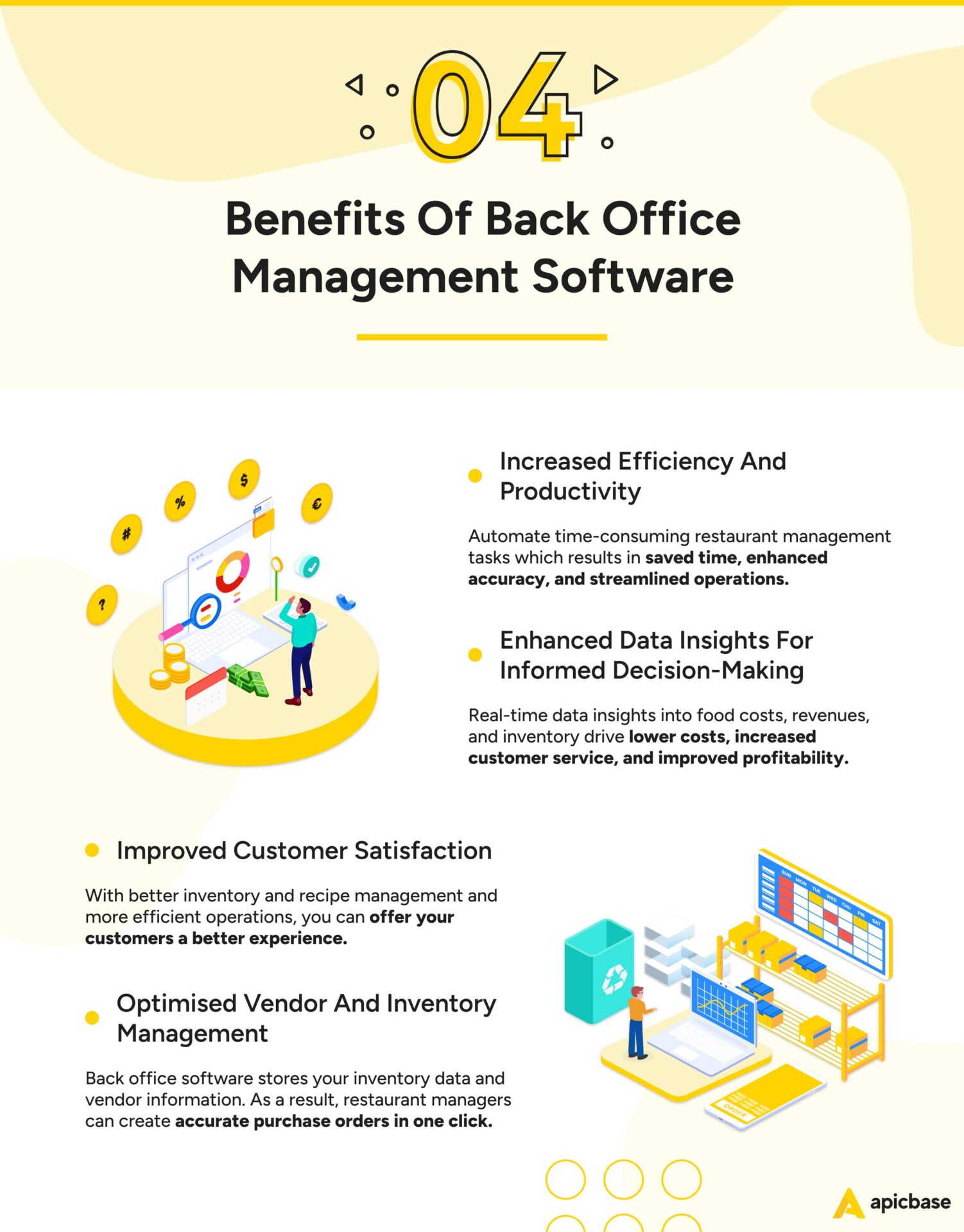
Automating restaurant back office tasks enables restaurant managers to make better decisions, cut costs, and improve overall operational efficiency.
Let’s dive deeper into the numerous benefits of back office software for restaurants.
Increased efficiency and productivity
Restaurant management involves many time-consuming, repetitive tasks that must be performed daily, from creating prep lists to stock counts and sending invoices.
Back office software automates many of these daily chores, allowing staff to work on other tasks. For example, restaurant software automatically tracks inventory levels, so your kitchen teams don’t have to count stock every night to order for the next day. Another example is software that stores recipe data and produces production plans based on predicted demand. This automation saves time and leads to more accurate production and less waste.
The benefits are even more impactful in larger businesses, with savings compounding across many locations and larger teams.
Enhanced data insights for informed decision-making
Data is the new gold. That’s what experts say. But, to tap into its true value, data has to be mined properly.
If you use disparate systems to run your restaurants, all data becomes siloed. It has to be exported and consolidated in Excel. This is an error-prone and time-consuming process that reduces the value of the data because insights from across the company remain hidden or difficult to access.
Linking your front- and back-of-house systems with software integration offers comprehensive insights into your business operations. The best restaurant analytics software gives you a holistic view of sales and inventory data, enabling you to make informed decisions quickly and effectively.
With real-time data, you gain a deeper understanding of food costs, revenues, and inventory levels. This allows your employees to make better on-the-spot decisions and management to take a strategic approach.
As a result, costs are lower, and your teams can serve more customers, improving the business’s profitability.
Improved customer satisfaction
With better inventory and recipe management and more efficient operations, you can offer your customers a better experience.
Your staff will be less burdened and therefore able to offer better service. You will have clear menus with accurate allergen information and everything available to order. And you can pass on savings to your customers to offer better value for money.
Optimised vendor and inventory management
Back office software stores your inventory data and vendor information. As a result, your restaurant managers have access to real-time supplier prices. The software automatically generates purchase orders based on current stock levels and upcoming demand. This dramatically reduces human error in the procurement department. A measured inventory leads to massive food cost savings.
When you have the purchasing and inventory data of all your restaurants and their suppliers in one place, connected meaningfully, you gain total control over your biggest cost centre. This will help facilitate more robust relationships with your suppliers, making securing better deals and negotiating better prices easier.
Essential Features of Restaurant Back Office Software
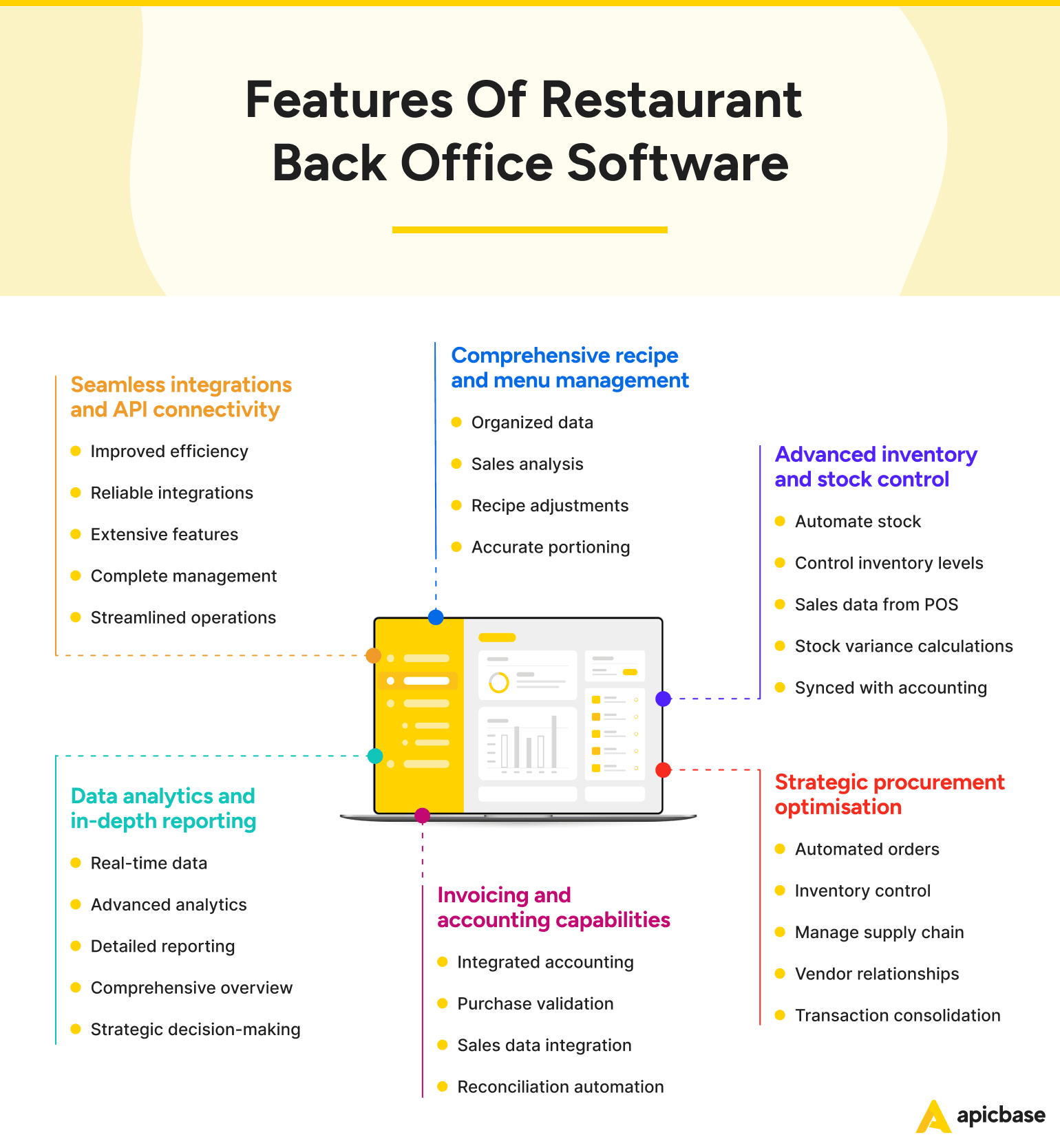
Now that we understand the benefits, the question remains: what key functionalities should a back-of-house system have to improve your operations effectively?
Here are the features to look for in back office software for food service operations.
Comprehensive recipe and menu management
Back office software stores your restaurant’s most crucial data, including recipe and menu data, which are the core of operations.
With all your ingredients, quantities, preparation methods, prices, and allergen information organised in one system, the software has immense power to automate tasks.
Menu engineering tools analyse your sales data to determine your most popular and profitable dishes. This enables you to make data-driven changes to recipes and ingredient usage or tweak portioning to maximise sales and menu profitability.
Your menu developers can create recipes with accurate portioning by dragging and dropping ingredients. The recipes are thoroughly calculated and automatically include allergens, nutritional information, and, where needed, an official Nutri-score. Head chefs can add visual instructions for correct preparation and plating to each recipe. This makes the menu roll-out across all restaurant units exceptionally efficient.
The best software also calculates food costs and variance with accurate real-time data from across the business.
Advanced inventory and stock control
Gone are the days of tedious manual stock counts and tricky inventory calculations using pen and paper. Modern back office software uses your restaurant data to automate stock management and control inventory levels with devilish accuracy.
Look for software that allows for digital stock counts on tablets to speed up manual counts. The best systems take sales data from your POS system to automate inventory depletion and stock variance calculations. They also link to your accounting software to send the information needed for invoicing and bookkeeping.
Strategic procurement optimisation
Software that digitises and automates procurement functions can transform purchasing efficiency for businesses with multiple outlets. No more searching through emails for invoices or phoning suppliers to place orders.
These systems organise all your supplier interactions in one place. You can automate orders based on accurate inventory and sales data and ensure that inventory levels are under control.
Organising everything on a digital F&B management platform promotes transparency throughout your supply chain and enhances vendor relationships. By consolidating all transaction details in one place, the system makes negotiating and getting the best prices easier.
Invoicing and accounting capabilities
Look for back office software with built-in accounting features or robust integrations with specialist restaurant accounting software.
Back office software with accounting features allows you to automate financial tasks like invoicing and generating reports. It matches purchase orders with invoices for efficient validation, ensuring payments are made only for verified deliveries.
Advanced software connects sales data with other systems, automating the reconciliation of orders, deliveries, and invoices to speed up payments.
Data analytics and in-depth reporting
Maintaining accurate, real-time sales and cost data from back office software is crucial for refining menus and recipes to enhance profitability.
The best systems combine advanced analytics tools with reporting dashboards to offer detailed menu performance and profitability insights.
Look for a system that provides a comprehensive overview across different locations, aiding in strategic decision-making for menu engineering and optimal inventory management.
Seamless integrations and API connectivity
APIs enable software systems to communicate, enhancing their functionality. Choosing software with reliable API integrations allows you to add more features and get more out of your data by connecting various systems like POS, inventory, and accounting.
Apicbase has an extensive catalogue of integrations with POS systems, supplier databases, allergen information services, and business intelligence tools. The integrations combined with Apicbase’s complete range of restaurant management features and API capabilities make it a complete end-to-end back office management platform.
Tips for Choosing Restaurant Back of House Software
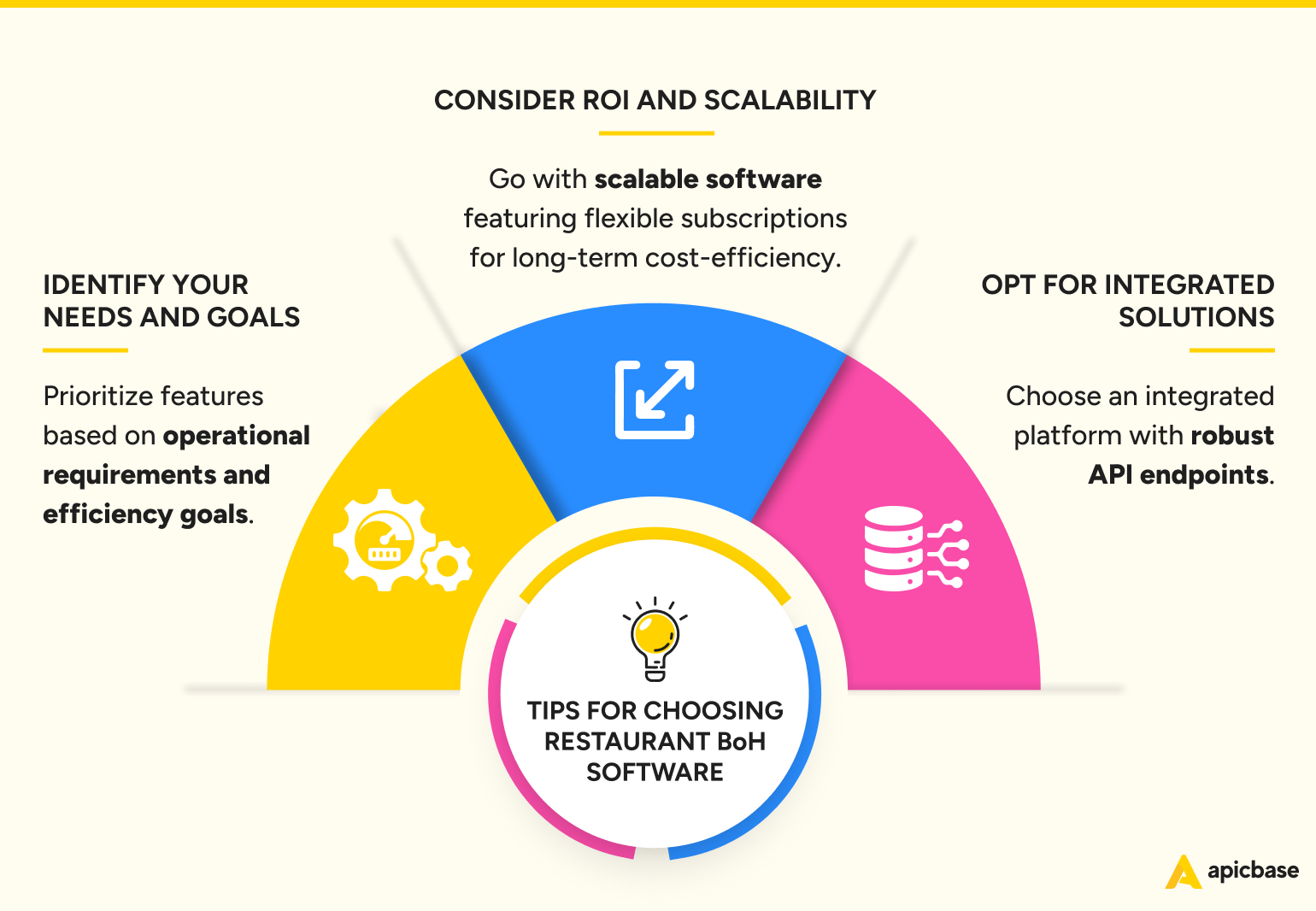
When you’re in the market for restaurant back office software, the first step is to determine your business goals. Consider the size of your business, the features you require, and the software’s scalability. With the software’s scalability, you can find the right software at the right price for your requirements.
Identify your restaurant’s needs and goals
Large multi-outlet restaurant companies have very different operational needs from single-unit restaurants or small groups. An independent restaurant with a simple menu may not need to automate production planning. But this would make a massive difference for a multi-unit food service company that uses central production kitchens for food preparation.
Look at where software would have the most significant impact on your business. Then, identify your must-have features based on the maximum efficiency gains.
Consider ROI and scalability
When you’re growing fast, you need to look ahead and find a solution that will suit you not just today, but in a year or ten years. Changing your restaurant software and re-training staff is a major inconvenience and expense.
A scalable solution that allows you to add more users, locations, and features as you need them means you never have to worry about switching platforms. Look for software with subscription tiers to level up as you require more functionality.
Opt for simplified, integrated solutions.
The best solution allows data sharing across your whole business. Managing everything in one place is the most efficient way to run a large organisation. It means you have all your data in one system, so you can gain holistic insights to make the right decisions.
Apicbase is an all-in-one solution with modules that cover every aspect of back of house operations, from inventory and procurement, to central kitchen management and accounting.
Harmonise Complex Operations
Apicbase offers a comprehensive BOH management solution that integrates with all your other restaurant systems.
Food service companies worldwide use it daily to improve efficiency, centralise restaurant data, and improve customer experience.
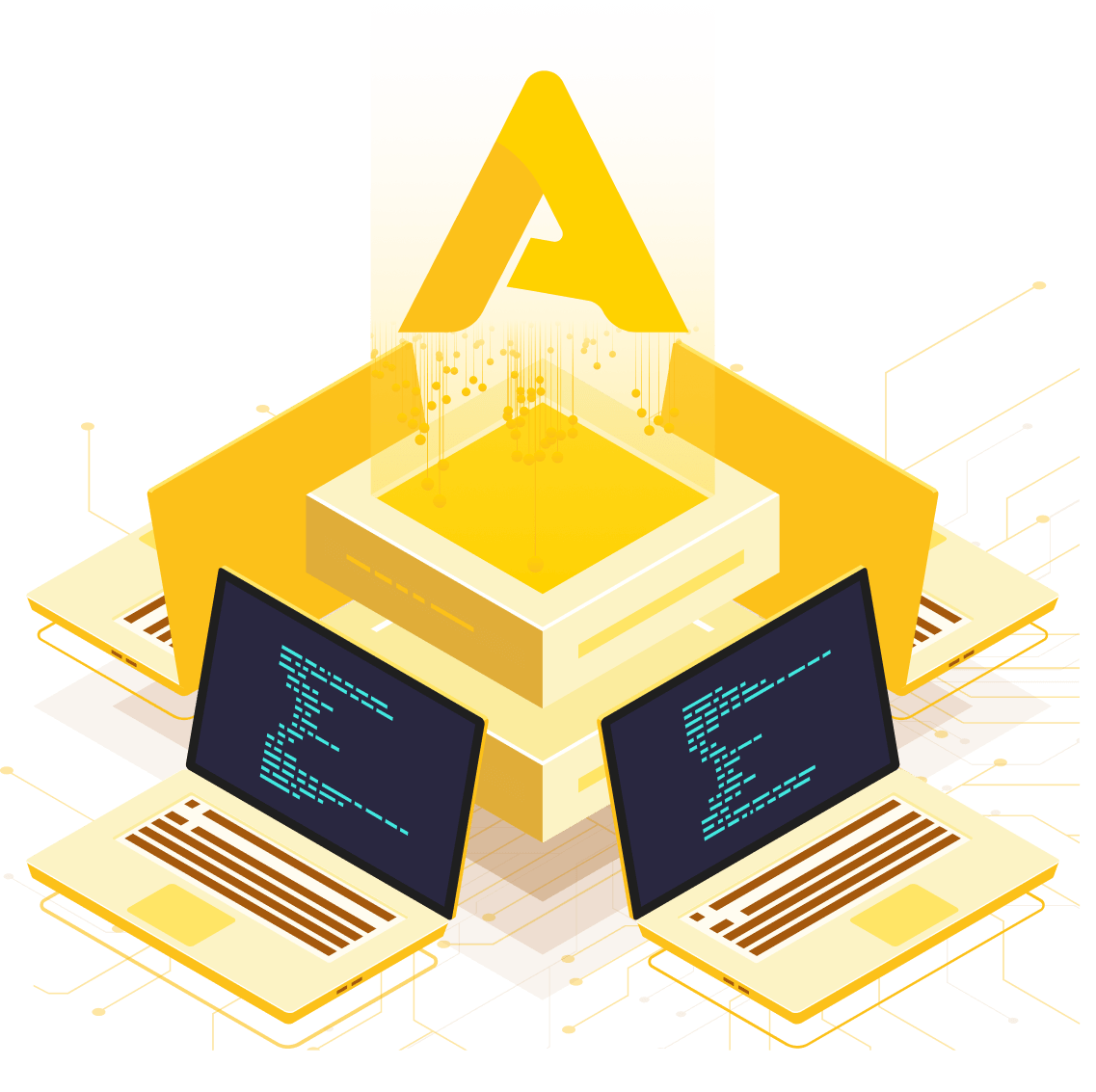
Experience the Power of Apicbase
The best way to see how back office software transforms your operations is to try it yourself.
Get in touch to see Apicbase in action.

